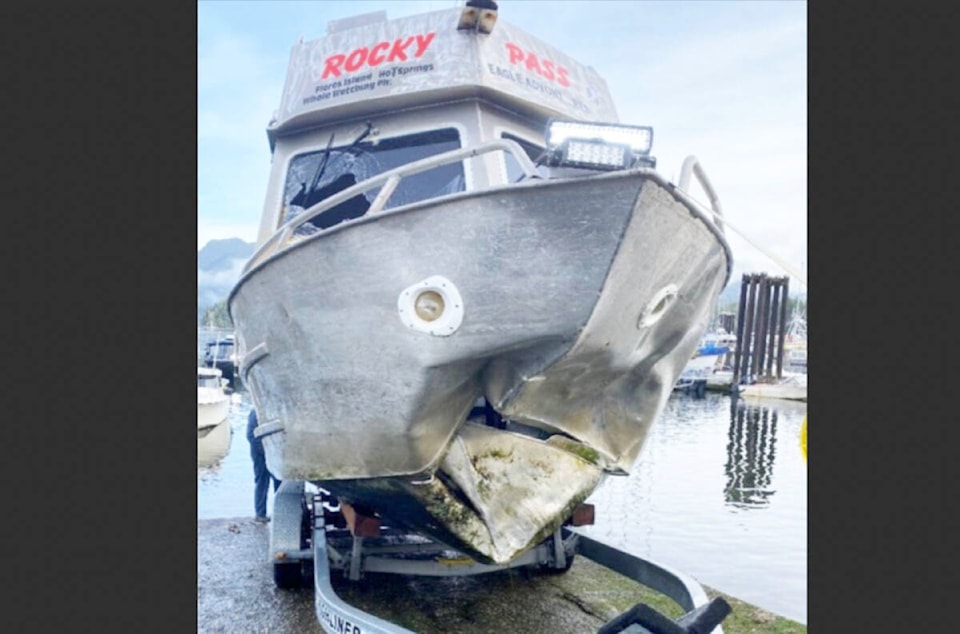A frozen GPS and foggy conditions were key factors in a water taxi crash last year, according to the Transportation Safety Board of Canada.
The TSB released an investigation report on the Jan. 25, 2022, incident and determined that the driver of the aluminium Rocky Pass was attempting to reset the frozen GPS when he spotted a rock directly in front of the vessel and was unable to avoid it.
“The impact caused the vessel to come to an abrupt stop,” the report reads. “The operator was thrown forward out of his seat and struck the front window but was subsequently able to stop the engines and transmit a Mayday call using the VHF radiotelephone with the assistance of one of the passengers.”
It adds that the driver and three of the passengers sustained serious injuries in the crash and the fourth passenger sustained minor injuries.
Bystander vessels, as well as the Coastal Nations Coast Guard Auxiliary and Canadian Coast Guard responded to the scene and the vessel’s five occupants were taken to the Tofino General Hospital. The vessel was significantly damaged and towed to Tofino.
The report explains that the Rocky Pass was on its way to Ahousaht from Tofino for the driver’s second trip that day. Another water taxi had departed Tofino towards Ahousaht at roughly the same time and there were two other water taxis en route to Tofino.
The wind was calm, but there was “dense fog” and visibility was reported to be less than 20 metres.
The Rocky Pass’ driver had been operating water taxis in the area for about 20 years and followed the usual route water taxis take, traversing Coomes Bank.
“This route is the most direct; however, in several areas, it requires vessel operators to navigate between or near navigational hazards, including drying rocks. Restricted visibility makes these navigational hazards less noticeable to operators. Without a radar, vessel operators must use their line of sight to monitor nearby vessel traffic and identify navigational hazards,” the report reads. “An alternative route exists along Calmus Passage, which is marked with navigation buoys…Along this route, the water is deeper and there are no drying rocks. It was not a practice for water taxis operating in the area to use this route on regular transits or when in restricted visibility.”
The driver was travelling at 22 knots and using the GPS until it froze.
“The Rocky Pass was transiting at 22 knots in an area with drying rocks and shallow water. Due to dense fog, the visibility at the time was less than 20 m. This speed in these conditions provided the operator with approximately 2 seconds to react to any navigational hazards. As well, the operator was relying on a single navigational aid, the GPS, to maintain a safe passage because the vessel’s radar was not in use during the voyage. When the GPS display froze, the operator had no back-up navigational aid to provide position information.”
The driver had also been exposed to fatigue, due to responding to a medical emergency at 10:30 p.m. the night prior.
“Ahousaht, like many other remote communities on the west coast of BC, relies on local community members with vessels to transfer patients to larger towns with medical facilities in the event of medical emergencies,” the report reads.
“At that time, the operator of the Rocky Pass was preparing to go to sleep as he had scheduled trips in the morning. He waited approximately 20 minutes to see if someone else would respond to the call, and when no one else did, he responded.”
The driver left Ahousaht for Tofino with the patient around 11 p.m. and stayed at the wharf in case the patient required a return trip that night, according to the report, which states that the driver slept in his boat before returning to Ahousaht at 2 a.m. without the patient. He woke up at 6:15 a.m. that morning for his scheduled trips, the first of which was at 6:45 a.m.
“Without a schedule to help identify which operators are available to conduct MEDEVACs on a given night, there is no predictability as to when operators may be asked to respond to MEDEVAC calls,” the report reads. “This unpredictability makes it challenging for operators to prioritize their hours of rest and exposes them to the risk of fatigue. Although it is not known if fatigue was a factor in this occurrence, performance decrements associated with fatigue are significant risk factors and predictors of occupational accidents and injuries, including in the marine industry.”
The report urges all vessel operators to carefully assess their route and take potential dangers into account, like weather and visibility, when considering their speed.
It adds that relying on a single electronic navigational aid can result in accidents.
“Mariners should continually cross-check their vessel’s position using all available means, including visual aids and radar,” it states.
andrew.bailey@westerlynews.ca
Like us on Facebook and follow us on Twitter
READ MORE: Investigation underway after water taxi crashes into buoy between Tofino and Ahousaht
READ MORE: Nuu-chah-nulth seek safety upgrade for Tofino harbour after two floatplane crashes
READ MORE: Four injured in water taxi crash near Tofino
